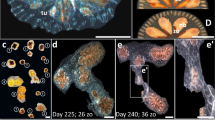Abstract
The evolution of altruism, cooperation and sociality should be favoured by mechanisms promoting interactions among relatives1,2. In turn, the opportunity for such interactions should be enhanced where related individuals are spatially associated. The simplest explanation for association of kin invokes philopatric, or limited, dispersal3. Alternatively, kin recognition—which is known from a broad array of taxa4,5—can produce similar associations. Neither the prevalence of kin recognition, nor aggregations of kin, are by themselves sufficient to demonstrate that kin recognition plays an important role in the production of nonrandom associations of relatives. To have such a role, kin recognition must promote or inhibit associations of kin beyond the effects of other processes, notably dispersal, that modify spatial patterns. Here we report the results of field experiments showing that sibling planktonic larvae of the sessile colonial ascidian Botryllus schlosseri settle in aggregations that are much stronger than expected from dispersal distance effects alone. Laboratory experiments indicate that larvae distinguish kin on the basis of shared alleles at a highly polymorphic histocompatibility locus known to regulate fusion between adult colonies. This kin recognition mechanism, along with limited dispersal of larvae, promotes co-settlement of histocompatible individuals. Consequently, the probability of fusion between adult colonies is far greater than that expected if larvae settled randomly
This is a preview of subscription content, access via your institution
Access options
Subscribe to this journal
Receive 51 print issues and online access
$199.00 per year
only $3.90 per issue
Buy this article
- Purchase on Springer Link
- Instant access to full article PDF
Prices may be subject to local taxes which are calculated during checkout
Similar content being viewed by others
References
Hamilton, W. D. J. theor. Biol. 7, 1–51 (1964).
Holmes, W. G. & Sherman, P. W. Am. Zool. 22, 491–517 (1982).
Shields, W. J., Inbreeding and the Evolution of Sex (State University of New York Press, Albany, 1982).
Sherman, P. W. & Holmes, W. G. Fortschr. Zool. 31, 437–459 (1985).
Keough, M. J. Evolution 38, 142–147 (1984).
van Duyl, F. C., Bak, R. P. M. & Sybesma, J. Mar. Ecol. Prog. Ser. 6, 35–42 (1981).
Olson, R. R. Ecology 66, 30–39 (1985).
Jackson, J. B. C. in Population Biology and Evolution of Clonal Organisms (eds Jackson, J. B. C., Buss, L. W. & Cook, R. E.) 297–356 (Yale University Press, New Haven, 1986).
Jackson, J. B. C. J. mar. Res. (in the press).
Kott, P. Proc. 2nd int. Coral ReefSymp. 1, 405–423 (1974).
Grave, C. & Woodbridge, H. J. Morph. Physiol 39, 207–247 (1924).
Clark, P. J. & Evans, F. C. Ecology 35, 445–453 (1954).
Simberloff, D. S. 60, 679–685 (1979).
Efron, B. & Gong, G. Am. Statistn 37, 36–48 (1983).
Bancroft, F. W. Proc. Calif. Acad. Sci. 3, 138–186 (1903).
Oka, H. & Watanabe, H. Bull. biol. Stn Asamushi 10, 153–155 (1960).
Sabbadin, A. Atti. Accad. naz. Lincei Rc. 32, 1031–1035 (1962).
Mukai, H. & Watanabe, H. Proc. Japan Acad. 51, 44–47 (1975).
Karakashian, S. & R. Biol Bull. 133, 473 (1967).
Curtis, A. S. G., Kerr, J. & Knowlton, N. Transplantation 33, 116–123 (1982).
Bak, R. P. M., Sybesma, J. & van Duyl, F. C. Mar. Ecol. Prog. Ser. 6, 43–52 (1981).
Russ, G. R. Oecologia 53, 12–19 (1982).
Reiswig, H. R. Bull. mar. Sci. 23, 191–226 (1973).
Fry, W. G. in 4th Eur. mar. biol Symp. (ed. Crisp, D. J.) 155–178 (Cambridge University Press, 1971).
Highsmith, R. C., Riggs, A. C. & D'Antonio, C. A. Oecologia 46, 322–329 (1980).
Wahle, C. M. Biol. Bull. 165, 778–790 (1983).
Hughes, T. P. & Jackson, J. B. C. Ecol Monogr. 55, 141–166 (1985).
Sebens, K. P. J. exp. mar. Biol Ecol 72, 263–285 (1983).
Buss, L. W. Proc. natn. Acad. Sci. U.S.A. 77, 5355–5359 (1980).
Winston, J. E. & Jackson, J. B. C. J. exp. mar. Biol. Ecol 76, 1–21 (1984).
Fadlallah, Y. H. Coral Reefs 2, 129–150 (1983).
Buss, L. W. Proc. natn. Acad. Sci. U.S.A. 79, 5337–5341 (1982).
Jones, W. E. Nature 178, 426–427 (1956).
Kaufmann, K. W. Oecologia 49, 293–299 (1981).
Hidaka, M. Coral Reefs 4, 111–116 (1985).
Buss, L. W. Proc. natn. Acad. ScL U.S.A. 80, 1387–1391 (1983).
Nieuwkoop, P. D. & Sutasurya, L. A. Primordial Germ Cells in the Invertebrates (Cambridge University Press, 1981).
Sabbadin, A. & Zaniolo, G. J. exp. Zool. 207, 289–304 (1979).
Buss, L. W. & Green, D. R. Devl comp. Immun. 9, 191–201 (1985).
Sabbadin, A. Devl Biol 24, 379–391 (1971).
Oka, H. in Profiles of Japanese Science and Scientists (ed. Yukawa, H.) 195–206 (Kodansha, Tokyo, 1970).
Scofield, V. L., Schlumpberger, J. L., West, L. A. & Weismann, I. L. Nature 295, 499–502 (1982).
Grosberg, R. K. Evolution (submitted).
Strathmann, R. R., Strathmann, M. & Emson, R.H. Am. Nat. 123, 796–818 (1984).
Yamazaki, K. E., Beauchamp, G. K., Bard, J., Thomas, L. & Boyse, E. A. Proc. natn. Acad. ScL U.S.A. 79, 7828–7831 (1982).
Author information
Authors and Affiliations
Rights and permissions
About this article
Cite this article
Grosberg, R., Quinn, J. The genetic control and consequences of kin recognition by the larvae of a colonial marine invertebrate. Nature 322, 456–459 (1986). https://doi.org/10.1038/322456a0
Received:
Accepted:
Issue Date:
DOI: https://doi.org/10.1038/322456a0
This article is cited by
-
Lessons from the study of plant mating systems for exploring the causes and consequences of inbreeding in marine invertebrates
Marine Biology (2021)
-
The lateral septum mediates kinship behavior in the rat
Nature Communications (2020)
-
Higher reproductive success for chimeras than solitary individuals in the kelp Lessonia spicata but no benefit for individual genotypes
Evolutionary Ecology (2016)
-
O father where art thou? Paternity analyses in a natural population of the haploid–diploid seaweed Chondrus crispus
Heredity (2015)
-
Allorecognition, Germline Chimerism, and Stem Cell Parasitism in the Colonial Ascidian, Botryllus schlosseri
Biological Theory (2014)
Comments
By submitting a comment you agree to abide by our Terms and Community Guidelines. If you find something abusive or that does not comply with our terms or guidelines please flag it as inappropriate.



